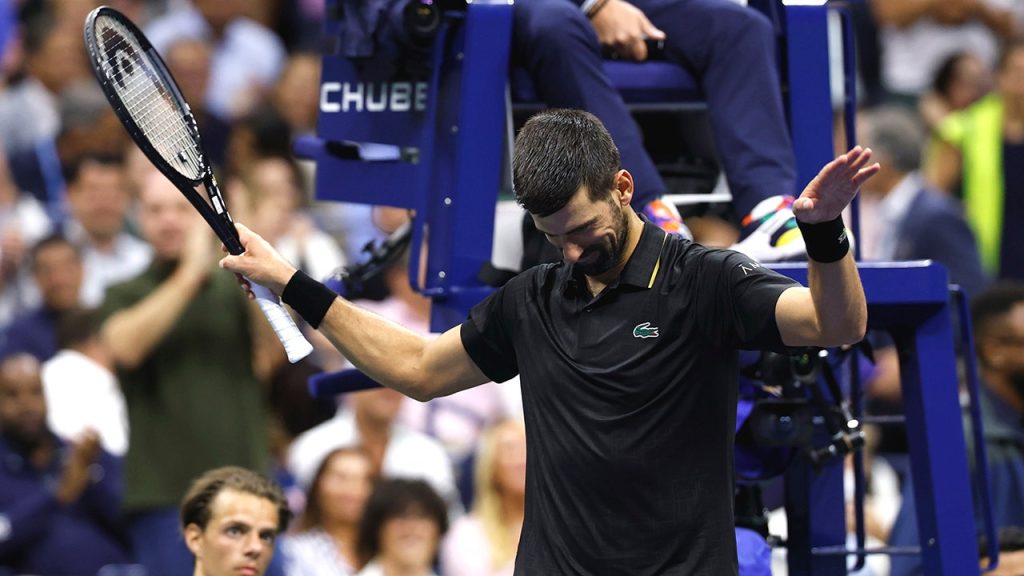Djokovic Triumphs Amid Hostile U.S. Open Crowd
In a tense and emotionally charged quarterfinal match at the U.S. Open, Novak Djokovic demonstrated once again why he remains one of tennis’s greatest competitors. Despite facing an unusually hostile crowd at Arthur Ashe Stadium late Tuesday night, the Serbian star overcame both the partisan atmosphere and a determined Taylor Fritz to advance to the semifinals with a 6-3, 7-5, 3-6, 6-4 victory. The match, which extended well into the night, revealed the complex relationship between Djokovic and American tennis fans, who heavily favored Fritz as the last American man standing in the tournament. The atmosphere grew increasingly contentious as the match progressed, creating a psychological battle that extended beyond the baseline exchanges.
As the match reached its halfway point, the crowd’s behavior became more aggressive, with fans repeatedly cheering for Djokovic’s faults – a breach of tennis etiquette. By the third set, when the clock had pushed past 10:30 p.m., Djokovic’s frustration boiled over. In a notable moment that encapsulated the tension, he approached chair umpire Damion Dumusois, repeatedly asking, “What are you going to do?” When Dumusois attempted to quiet the crowd with standard appeals for respect, Djokovic mockingly echoed his phrases: “Thank you. Please. Thank you. Please.” This interaction only fueled more booing from the partisan crowd, while Dumusois tried to reason with Djokovic, telling him, “It’s not going to help, Novak.” The exchange highlighted the psychological warfare that often accompanies high-stakes tennis matches, particularly when a beloved player faces a hostile environment.
Despite the distractions, Djokovic’s championship mettle ultimately prevailed. Though Fritz managed to capitalize on the crowd’s energy to claim the third set, Djokovic’s experience and tactical acumen proved decisive in the four-set victory. The statistics reveal the grinding nature of the contest – Djokovic won 25 of the 42 points that lasted at least nine strokes, saved 11 of 13 break chances, and impressively won 10 of 11 points when employing serve-and-volley tactics. “I was just trying to survive,” Djokovic admitted candidly in his post-match interview. “It’s one of those days where you just have to grind.” This statement perfectly encapsulates the resilience that has defined his career – the ability to find solutions even when not playing his best tennis, and to weather not just physical challenges but emotional ones as well.
The victory propels the 38-year-old Djokovic into a highly anticipated semifinal showdown with world No. 2 Carlos Alcaraz, setting the stage for what could be one of the tournament’s most electrifying matches. The contrast between the veteran Djokovic and the young Spanish sensation Alcaraz represents one of tennis’s most compelling current rivalries. For Djokovic, this semifinal appearance extends an already remarkable legacy at the U.S. Open and offers another opportunity to add to his record-breaking collection of Grand Slam titles. His ability to silence the crowd with his play, ultimately blowing kisses to those who had jeered him earlier, demonstrated the psychological fortitude that has made him one of the sport’s all-time greats – capable of turning hostility into motivation.
For Fritz, the defeat carries additional significance beyond his personal journey. His exit extends a painful drought for American men’s tennis at the Grand Slam level that has now stretched over two decades. Not since Andy Roddick’s triumph at the 2003 U.S. Open has an American man captured a major singles title. Despite Fritz’s valiant effort and the passionate support of the home crowd, this reality remains unchanged. The weight of this national expectation undoubtedly added pressure to Fritz’s performance, while simultaneously fueling the crowd’s emotional investment in the match. American tennis fans, desperate for a homegrown champion, channeled their hopes through their vocal support of Fritz and corresponding antagonism toward Djokovic.
The match ultimately served as a microcosm of the broader tennis landscape – the established champion continuing to fend off challenges from the next generation, the tension between individual achievement and national pride, and the powerful role that crowd dynamics can play in the sport’s most important moments. As Djokovic moves forward in the tournament, his interaction with the Arthur Ashe crowd may have changed, perhaps earning respect through his resilience if not affection through personality. This quarterfinal contest demonstrated once again that tennis, while ostensibly an individual sport, is shaped by complex social and emotional factors that extend far beyond the baseline. Whether Djokovic can translate this hard-fought victory into another championship run remains to be seen, but his ability to thrive amid adversity suggests he remains as dangerous as ever, regardless of which side of the crowd’s favor he finds himself on.


